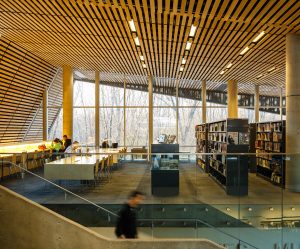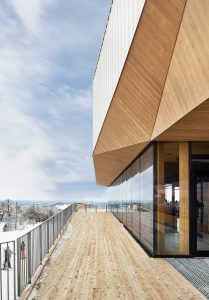- February 17, 2022
A defining element of Canadian design with a character unlike any other
The forest industry has a long, storied history and an expansive presence in Canada, and that’s made wood one of the distinctive building materials in Canadian design. In Québec, one of the top three one of the top three Canadian provinces¹ specializing in forest products with 750,000 km² of sprawling forests, wood is both a reliable resource and prominent feature in the province’s northern architecture.
With a wide range of colours and lustres and textures and grains, the beauty and durability of this natural element can be found in a variety of spaces, from the residential to the commercial and beyond. Locally sourced and renewable, it is a building material that serves to lessen our carbon footprint and—in the right hands—can make any space feel warm, welcoming, and aesthetically pleasing.
A strong and sustainable resource

Wood provides a strong structure for buildings, often better at supporting its own weight than other materials such as steel. When measured against it, wood outperforms steel in tensile strength.
This lightweight building material can support its own weight when it comes to break-length, which means fewer supports are needed when designing large spaces. Its strength and dimensions are not significantly affected by heat, providing extra structural stability. Sound absorption is also a plus thanks to wood’s acoustic properties, reducing noise levels which in turn improves the comfort of those inside.
Wood also scores highly as a local renewable resource. Unlike concrete and steel, wood can be grown and regrown naturally. Replanting programs, select harvesting and other practices prioritizing sustainability allow growth to continue while larger trees are harvested. As opposed to inert stone and metal, maturing forests are also naturally and efficiently removing carbon dioxide from the environment.
The biophilic powers of wood
Humans have a deep connection to and love of nature. According to numerous studies in urban areas, when natural elements are integrated into architectural design, it can positively influence a person’s emotions and perceptions of their environment. That’s the basis of biophilic design, which seeks to connect people to nature through our built environments.
Wood is a superb vehicle for biophilic design. Its colours and physical properties bring that connection to nature to life, where just so much as seeing wood can remind us of being surrounded by trees in a forest, which has been shown to lead to stress reduction. Just like the forests it’s sourced from, the use of wood also promotes air quality and absorbs sound, contributing to a peaceful environment, while humidity and temperature is better regulated which promotes greater human comfort and cost-saving.
By adding the element of wood to a built environment, nature can be evoked through touch, smell, sight and sound, and that can make for a lot of positive emotions in both the present and the future.
 Wood as ambiance
Wood as ambiance
An example of wood use and biophilic design, the Bromont Summit Chalet in Quebec’s Eastern Townships is a celebration of the region’s natural resources: The combination of an exposed laminated wood structure and a light wooden frame demonstrates the character of the material through quality architecture, a refined detail also found in the ceiling’s wooden slats that allows a harmonious integration of the lighting.
From below, the chalet exposes its interior wooden shell which diffuses a soft and natural glow onto the summit in the evening. Compressing the space at certain times and expanding it at others, the architecture unfolds on several levels to offer spectators different observation points within the building. Like a warm, natural wooden nest, this place of rest, relaxation and contemplation allows visitors a break from the elements while maintaining contact with nature.
Wood in public transportation
The Réseau express métropolitain (REM) is a 67-km light rail system with 26 stations linking downtown, the airport and the Greater Montréal area. Integrating architecture, urban design and landscape architecture, the goal was to develop a user-centred, sustainable design.
The integration of local character was deemed paramount, including unifying design elements to create an overarching network signature. An example of this is the use of wood in every station’s ceiling, which adds warmth and aesthetic continuity while exemplifying the historic importance of Quebec’s wood industry.
Wood, a natural choice
Wood is beneficial for its structurally functional properties, but once we are immersed in a living environment built from it, we’re quickly reminded of how it can positively influence people and the planet. Using wood is a sustainable choice and a testament to the history of a region it is sourced from, but above all, it’s a way to bring the peaceful feeling of nature into urban spaces through design.
¹ source: https://www.bnq.qc.ca/en/standardization/forestry.html